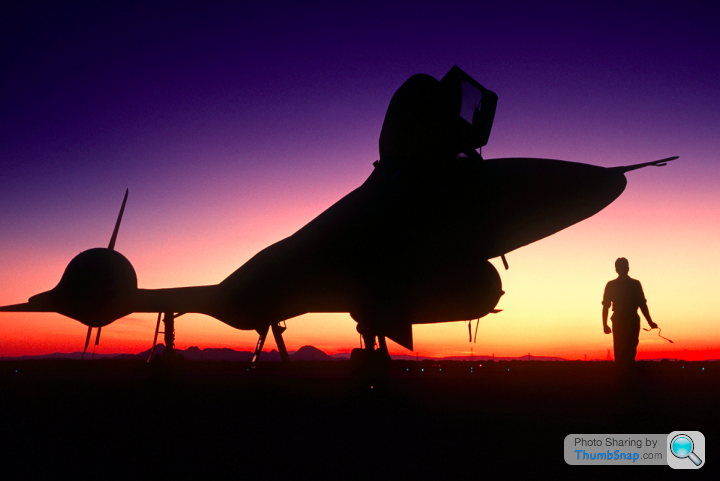Post amazingly cool pictures of aircraft (Volume 2)
Discussion
Voldemort said:
MartG said:
Laarbruch - pic of everyone on the base ( sorry, no idea of the date )

Why has the front plane got a red tail? Squadron leaders personal mount or some other reason?
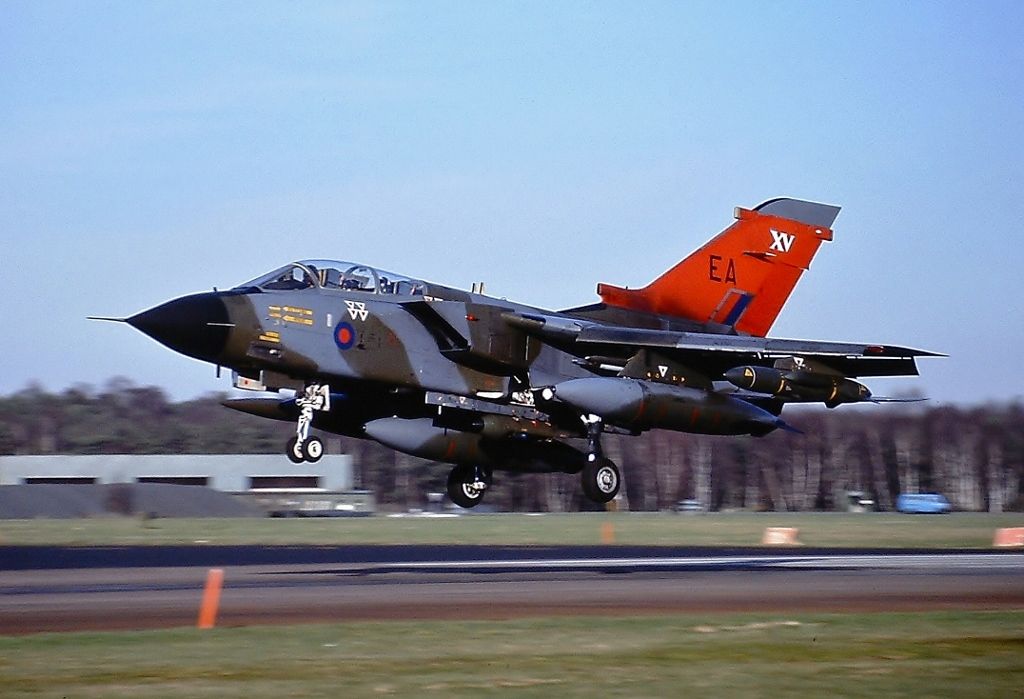
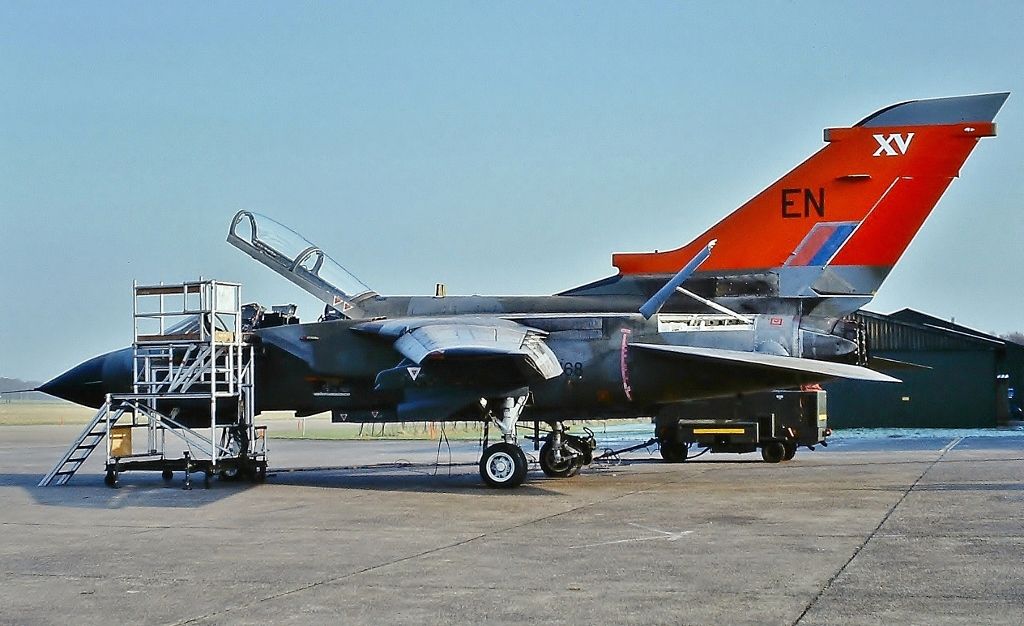
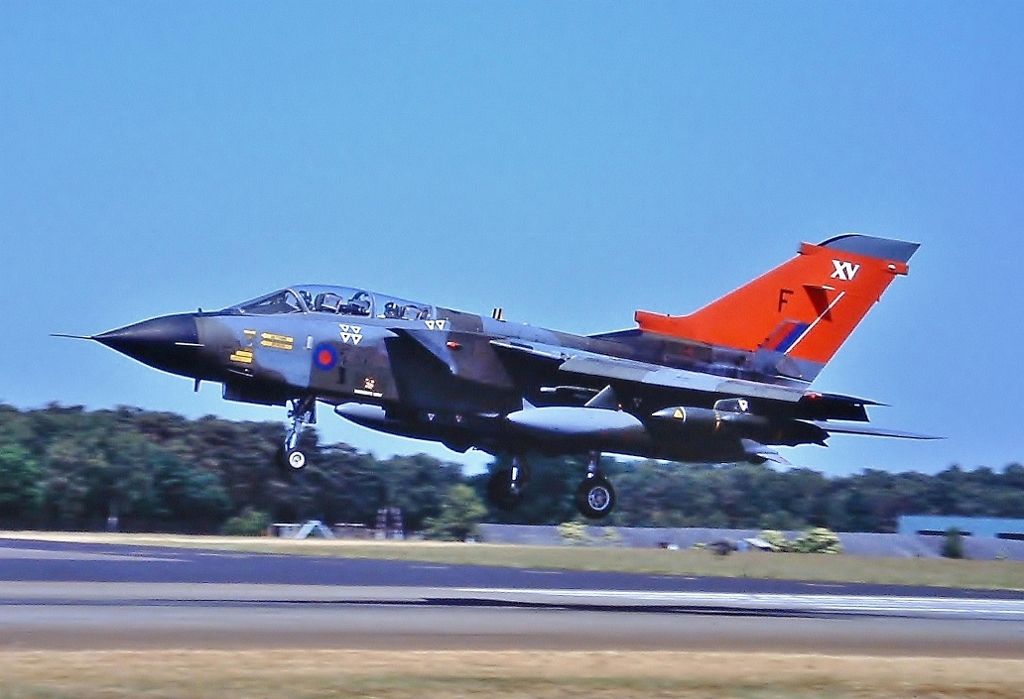
...along with another celebratory scheme...
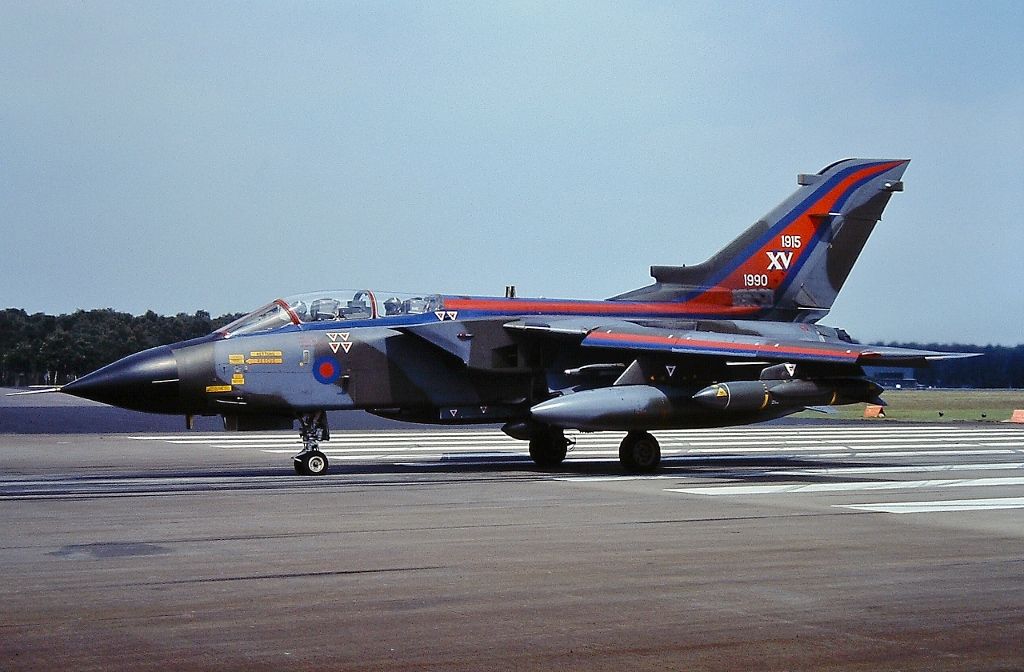
I take no credit for the photos. That belongs to Hywel 'Taff' Evans on the Fighter Control website... http://www.fightercontrol.co.uk/forum/viewtopic.ph...
Created as an RFC squadron in 1915, XV Squadron (Aim Sure) celebrated their 70th anniversary in 1985, and their 75th anniversary in 1990.
Some images as a Youtube slide show here... https://www.youtube.com/watch?v=hepBcPTlvp0
Some squadron history for the Tornado period here... https://sites.google.com/site/raflaarbruch/home/la...
XV Squadron disbanded at the end of 1991, but was resurrected in 1992 as a (Reserve) OCU squadron in the crew training role. It was again disbanded in March 2017. Some more squadron history here...
http://xvsqnassociation.co.uk/xv%20sqn%20history/i...
...and...
https://www.raf.mod.uk/raflossiemouth/aboutus/xvrs...
...along with the usual Wikipedia link... https://en.wikipedia.org/wiki/No._15_Squadron_RAF
Celebratory paint schemes on RAF aircraft doesn't seem to be an unusual 'thing'...





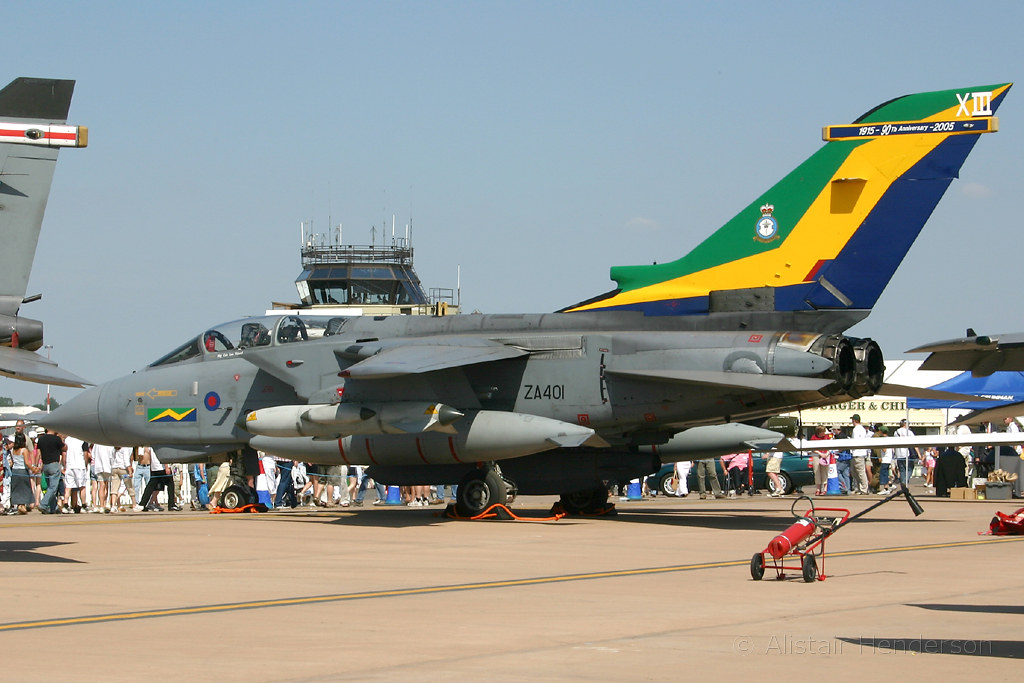
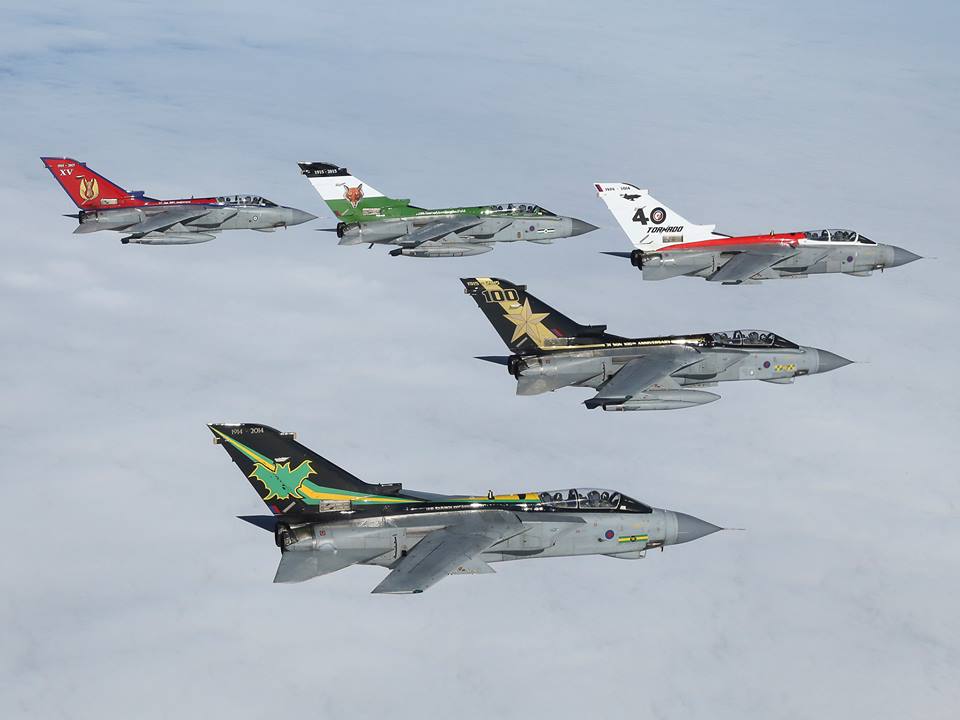
Source for this photo... https://theaviationist.com/2015/09/18/five-tornado... ...with additional video on that page.
...and more here... https://www.google.co.uk/search?tbm=isch&sourc...
Edited by yellowjack on Wednesday 20th September 09:00
Druid said:
Probably part of Conspicuity Trials carried out to 'Hi Viz' aircraft. The one in the photo is probably ZA446 of XV Sqn and placed at the front as they were the premier Sqn at Laarbruch. 
Evolution of a Tornado...

GR 1
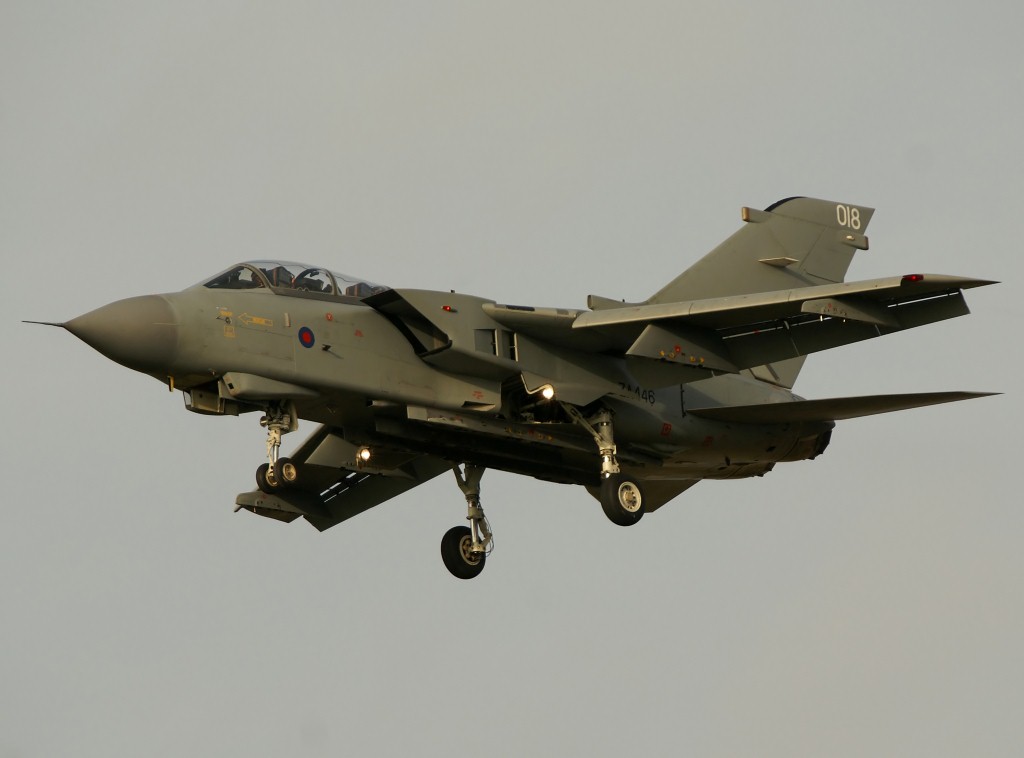
GR 4

Fly no more
Damaged in 2009...
23/09/2009 - ZA446 - Tornado GR4 - 2 Sqn - Diverted to Leuchars, Fife while on a sortie from Marham after suffering a non contained titanium fire in the right hand engine which lead to a major fire in the engine bay. Although categorized as CAT3 a rebuilt was not authorized and it was sent to Shawbury for store in 2010. http://www.ukserials.com/losses-2009.htm
yellowjack said:
That is also the MacRoberts Reply Jet http://xvsqnassociation.co.uk/xv%20sqn%20history/x...Ejection seats, Canberra B-2 version.. ( via Philip Ward )
The Canberra being a new national pride had to have "everything". So, ejection seats all-round, as the saying goes. I don't think at the time of conception that anybody knew how the Canberra would be used operationally. They were likely fighting the last war as generals do. So, if an ME 110 attacked you, you needed an escape. The Spitfire pilots just flung back the cockpit hood and rolled out. That would be the thinking around the Whitehall table.
When it turned out that these planes were going to fly at night at high altitude ... Mainly over water! Whoa!
Our principal safety device was the seat. The theory was that if things got too unbearable, you blew the hatch above your head and ejected through the hole. The dilemma presented was, when was it permissible to eject? The RAF were not forgiving of fools making a mess of their planes. You had to have watertight justification for getting out. Since there were three of us, this would require a consensus which might result in a critical delay in an emergency. By the time the vote was in it could be too late! Ejection could be made impossible by G-force if the plane got into an uncontrolled maneuver. Ejection was not the end of the emergency however...
Ours was not the device that opened at low altitude and automatically deployed the chute. Ejection at low altitude would probably mean that you wouldn't have time to get free of the seat and open your chute. You would probably need 5,000 feet to operate it properly. At high-altitude such as we normally operated, there is little usable oxygen in the atmosphere. They kindly provided a ten-minute supply in the seat but this required staying with it until a lower altitude was attained at which time you could separate from the seat and then open the parachute. All this seemed to imply having one's wits about you.
The procedure was as follows: Bang!! Into the night at 45,000 feet and -60 degrees C at an airspeed of 200 knots. True airspeed was around 600 but lack of air at altitude gives an apparent speed much lower (which is nice) Who needs to be hit by a more than 200 knot gale? The seat deployed a little drogue chute to stabilize itself for the long drop through space. This was to prevent a tumble through the skies that would disorient a person. Hopefully the blast would not have ripped off your oxygen mask.The blast into the slipstream, though minimized by the lack of air at this altitude has been known to take one's flying boots off and break one's legs by splaying them apart. The close dimensions of the hatch through which we were exiting also gave me cause for concern. Turns out the pilot had his own problem missing the joystick!
Then the descent. It takes two and a half minutes to fall to 12,000 feet from 45,000. Of course, having brought your slide rule along, you can work out how long it would take to fall from say, 35,000 feet. You will probably have noted the exact instant on your watch and altitude at which you ejected so that you can time your descent accurately! Some hope! You can see that the descent is going to be characterized by pure panic as you try to judge when you are low enough to separate from the reserve oxygen supply and the seat. At 12,000 feet or below you were required to disconnect the seat belt and kick free off the seat. Make sure that you don't disconnect from the parachute too! So many straps! Many pilots have hit the parachute release button before tumbling out of their plane in combat. After all, after every flight that’s what you do automatically on your way out! When the seat is out of the way, it is safe to open the chute. Now, if all this is done at night, you will have precious little idea of what has gone on and where you are. Totally disoriented would be a good way to describe it. Still, you may find yourself getting this far without problems! Prepare now to land, or more like it, splash down in the sea. Likely the nice black North Sea. Make sure you don't disconnect from the chute too soon. Lots of lads, on seeing the seeming proximity of the waves, have hit the parachute disconnect button and fallen the last 200 feet free-fall! Not a good idea! It is very difficult to judge height over the sea, particularly at night, and since your next obstacle is to see that the parachute does not smother you by covering you in the water, there is a certain incentive to get out of that harness as promptly as possible. Besides, it's heavy and you are not going to swim with it on. After you hit the water then, get rid of the chute and harness. Inflate the Mae-West. It has a self-inflator bottle and a puffing tube in case that doesn’t work. Hopefully you remembered to connect yourself to that seat-pack containing your dinghy and the survival pack. Get into the dinghy! We did dinghy drills at Cranwell over two years ago. It is time to open up the survival pack and see what the Air Ministry has put in it for you. We were well prepared! The accommodation in a single man dinghy is downright cozy. That is, on a warm summer day when you are ready for a swim. Unfortunately, conditions were not likely to be anything like ideal since operational flights were always at night. Exposure times in the sea were not optimistically predicted. Still, the emergency pack containing water. We'd been sitting on the damned thing for hours. Hopefully it would be there when we wanted it. There were emergency rations, candy bars usually, and flares with which to signal your whereabouts. There was shark-repellant - a fluorescent compound that colored the water If not repelling sharks it might make one a little more visible in daylight...nobody's going to find you tonight lad!…And a whistle!
So this was our means for survival. I am not aware of anyone actually ejecting at night. When you consider what I have just explained, it is not hard to understand that on future V-bombers, the Air Council decided that ejection seats weren’t worth the investment...
Steve Beeney describes in his book two guys surviving such an escape in daylight. See www.thecanberraexperience.com for more ripping yarns.
The Canberra being a new national pride had to have "everything". So, ejection seats all-round, as the saying goes. I don't think at the time of conception that anybody knew how the Canberra would be used operationally. They were likely fighting the last war as generals do. So, if an ME 110 attacked you, you needed an escape. The Spitfire pilots just flung back the cockpit hood and rolled out. That would be the thinking around the Whitehall table.
When it turned out that these planes were going to fly at night at high altitude ... Mainly over water! Whoa!
Our principal safety device was the seat. The theory was that if things got too unbearable, you blew the hatch above your head and ejected through the hole. The dilemma presented was, when was it permissible to eject? The RAF were not forgiving of fools making a mess of their planes. You had to have watertight justification for getting out. Since there were three of us, this would require a consensus which might result in a critical delay in an emergency. By the time the vote was in it could be too late! Ejection could be made impossible by G-force if the plane got into an uncontrolled maneuver. Ejection was not the end of the emergency however...
Ours was not the device that opened at low altitude and automatically deployed the chute. Ejection at low altitude would probably mean that you wouldn't have time to get free of the seat and open your chute. You would probably need 5,000 feet to operate it properly. At high-altitude such as we normally operated, there is little usable oxygen in the atmosphere. They kindly provided a ten-minute supply in the seat but this required staying with it until a lower altitude was attained at which time you could separate from the seat and then open the parachute. All this seemed to imply having one's wits about you.
The procedure was as follows: Bang!! Into the night at 45,000 feet and -60 degrees C at an airspeed of 200 knots. True airspeed was around 600 but lack of air at altitude gives an apparent speed much lower (which is nice) Who needs to be hit by a more than 200 knot gale? The seat deployed a little drogue chute to stabilize itself for the long drop through space. This was to prevent a tumble through the skies that would disorient a person. Hopefully the blast would not have ripped off your oxygen mask.The blast into the slipstream, though minimized by the lack of air at this altitude has been known to take one's flying boots off and break one's legs by splaying them apart. The close dimensions of the hatch through which we were exiting also gave me cause for concern. Turns out the pilot had his own problem missing the joystick!
Then the descent. It takes two and a half minutes to fall to 12,000 feet from 45,000. Of course, having brought your slide rule along, you can work out how long it would take to fall from say, 35,000 feet. You will probably have noted the exact instant on your watch and altitude at which you ejected so that you can time your descent accurately! Some hope! You can see that the descent is going to be characterized by pure panic as you try to judge when you are low enough to separate from the reserve oxygen supply and the seat. At 12,000 feet or below you were required to disconnect the seat belt and kick free off the seat. Make sure that you don't disconnect from the parachute too! So many straps! Many pilots have hit the parachute release button before tumbling out of their plane in combat. After all, after every flight that’s what you do automatically on your way out! When the seat is out of the way, it is safe to open the chute. Now, if all this is done at night, you will have precious little idea of what has gone on and where you are. Totally disoriented would be a good way to describe it. Still, you may find yourself getting this far without problems! Prepare now to land, or more like it, splash down in the sea. Likely the nice black North Sea. Make sure you don't disconnect from the chute too soon. Lots of lads, on seeing the seeming proximity of the waves, have hit the parachute disconnect button and fallen the last 200 feet free-fall! Not a good idea! It is very difficult to judge height over the sea, particularly at night, and since your next obstacle is to see that the parachute does not smother you by covering you in the water, there is a certain incentive to get out of that harness as promptly as possible. Besides, it's heavy and you are not going to swim with it on. After you hit the water then, get rid of the chute and harness. Inflate the Mae-West. It has a self-inflator bottle and a puffing tube in case that doesn’t work. Hopefully you remembered to connect yourself to that seat-pack containing your dinghy and the survival pack. Get into the dinghy! We did dinghy drills at Cranwell over two years ago. It is time to open up the survival pack and see what the Air Ministry has put in it for you. We were well prepared! The accommodation in a single man dinghy is downright cozy. That is, on a warm summer day when you are ready for a swim. Unfortunately, conditions were not likely to be anything like ideal since operational flights were always at night. Exposure times in the sea were not optimistically predicted. Still, the emergency pack containing water. We'd been sitting on the damned thing for hours. Hopefully it would be there when we wanted it. There were emergency rations, candy bars usually, and flares with which to signal your whereabouts. There was shark-repellant - a fluorescent compound that colored the water If not repelling sharks it might make one a little more visible in daylight...nobody's going to find you tonight lad!…And a whistle!
So this was our means for survival. I am not aware of anyone actually ejecting at night. When you consider what I have just explained, it is not hard to understand that on future V-bombers, the Air Council decided that ejection seats weren’t worth the investment...
Steve Beeney describes in his book two guys surviving such an escape in daylight. See www.thecanberraexperience.com for more ripping yarns.
MartG said:
Ejection seats, Canberra B-2 version.. ( via Philip Ward )
The Canberra being a new national pride had to have "everything". So, ejection seats all-round, as the saying goes. I don't think at the time of conception that anybody knew how the Canberra would be used operationally. They were likely fighting the last war as generals do. So, if an ME 110 attacked you, you needed an escape. The Spitfire pilots just flung back the cockpit hood and rolled out. That would be the thinking around the Whitehall table.
When it turned out that these planes were going to fly at night at high altitude ... Mainly over water! Whoa!
Our principal safety device was the seat. The theory was that if things got too unbearable, you blew the hatch above your head and ejected through the hole. The dilemma presented was, when was it permissible to eject? The RAF were not forgiving of fools making a mess of their planes. You had to have watertight justification for getting out. Since there were three of us, this would require a consensus which might result in a critical delay in an emergency. By the time the vote was in it could be too late! Ejection could be made impossible by G-force if the plane got into an uncontrolled maneuver. Ejection was not the end of the emergency however...
Ours was not the device that opened at low altitude and automatically deployed the chute. Ejection at low altitude would probably mean that you wouldn't have time to get free of the seat and open your chute. You would probably need 5,000 feet to operate it properly. At high-altitude such as we normally operated, there is little usable oxygen in the atmosphere. They kindly provided a ten-minute supply in the seat but this required staying with it until a lower altitude was attained at which time you could separate from the seat and then open the parachute. All this seemed to imply having one's wits about you.
The procedure was as follows: Bang!! Into the night at 45,000 feet and -60 degrees C at an airspeed of 200 knots. True airspeed was around 600 but lack of air at altitude gives an apparent speed much lower (which is nice) Who needs to be hit by a more than 200 knot gale? The seat deployed a little drogue chute to stabilize itself for the long drop through space. This was to prevent a tumble through the skies that would disorient a person. Hopefully the blast would not have ripped off your oxygen mask.The blast into the slipstream, though minimized by the lack of air at this altitude has been known to take one's flying boots off and break one's legs by splaying them apart. The close dimensions of the hatch through which we were exiting also gave me cause for concern. Turns out the pilot had his own problem missing the joystick!
Then the descent. It takes two and a half minutes to fall to 12,000 feet from 45,000. Of course, having brought your slide rule along, you can work out how long it would take to fall from say, 35,000 feet. You will probably have noted the exact instant on your watch and altitude at which you ejected so that you can time your descent accurately! Some hope! You can see that the descent is going to be characterized by pure panic as you try to judge when you are low enough to separate from the reserve oxygen supply and the seat. At 12,000 feet or below you were required to disconnect the seat belt and kick free off the seat. Make sure that you don't disconnect from the parachute too! So many straps! Many pilots have hit the parachute release button before tumbling out of their plane in combat. After all, after every flight that’s what you do automatically on your way out! When the seat is out of the way, it is safe to open the chute. Now, if all this is done at night, you will have precious little idea of what has gone on and where you are. Totally disoriented would be a good way to describe it. Still, you may find yourself getting this far without problems! Prepare now to land, or more like it, splash down in the sea. Likely the nice black North Sea. Make sure you don't disconnect from the chute too soon. Lots of lads, on seeing the seeming proximity of the waves, have hit the parachute disconnect button and fallen the last 200 feet free-fall! Not a good idea! It is very difficult to judge height over the sea, particularly at night, and since your next obstacle is to see that the parachute does not smother you by covering you in the water, there is a certain incentive to get out of that harness as promptly as possible. Besides, it's heavy and you are not going to swim with it on. After you hit the water then, get rid of the chute and harness. Inflate the Mae-West. It has a self-inflator bottle and a puffing tube in case that doesn’t work. Hopefully you remembered to connect yourself to that seat-pack containing your dinghy and the survival pack. Get into the dinghy! We did dinghy drills at Cranwell over two years ago. It is time to open up the survival pack and see what the Air Ministry has put in it for you. We were well prepared! The accommodation in a single man dinghy is downright cozy. That is, on a warm summer day when you are ready for a swim. Unfortunately, conditions were not likely to be anything like ideal since operational flights were always at night. Exposure times in the sea were not optimistically predicted. Still, the emergency pack containing water. We'd been sitting on the damned thing for hours. Hopefully it would be there when we wanted it. There were emergency rations, candy bars usually, and flares with which to signal your whereabouts. There was shark-repellant - a fluorescent compound that colored the water If not repelling sharks it might make one a little more visible in daylight...nobody's going to find you tonight lad!…And a whistle!
So this was our means for survival. I am not aware of anyone actually ejecting at night. When you consider what I have just explained, it is not hard to understand that on future V-bombers, the Air Council decided that ejection seats weren’t worth the investment...
Steve Beeney describes in his book two guys surviving such an escape in daylight. See www.thecanberraexperience.com for more ripping yarns.
And the amazingly cool picture is where?The Canberra being a new national pride had to have "everything". So, ejection seats all-round, as the saying goes. I don't think at the time of conception that anybody knew how the Canberra would be used operationally. They were likely fighting the last war as generals do. So, if an ME 110 attacked you, you needed an escape. The Spitfire pilots just flung back the cockpit hood and rolled out. That would be the thinking around the Whitehall table.
When it turned out that these planes were going to fly at night at high altitude ... Mainly over water! Whoa!
Our principal safety device was the seat. The theory was that if things got too unbearable, you blew the hatch above your head and ejected through the hole. The dilemma presented was, when was it permissible to eject? The RAF were not forgiving of fools making a mess of their planes. You had to have watertight justification for getting out. Since there were three of us, this would require a consensus which might result in a critical delay in an emergency. By the time the vote was in it could be too late! Ejection could be made impossible by G-force if the plane got into an uncontrolled maneuver. Ejection was not the end of the emergency however...
Ours was not the device that opened at low altitude and automatically deployed the chute. Ejection at low altitude would probably mean that you wouldn't have time to get free of the seat and open your chute. You would probably need 5,000 feet to operate it properly. At high-altitude such as we normally operated, there is little usable oxygen in the atmosphere. They kindly provided a ten-minute supply in the seat but this required staying with it until a lower altitude was attained at which time you could separate from the seat and then open the parachute. All this seemed to imply having one's wits about you.
The procedure was as follows: Bang!! Into the night at 45,000 feet and -60 degrees C at an airspeed of 200 knots. True airspeed was around 600 but lack of air at altitude gives an apparent speed much lower (which is nice) Who needs to be hit by a more than 200 knot gale? The seat deployed a little drogue chute to stabilize itself for the long drop through space. This was to prevent a tumble through the skies that would disorient a person. Hopefully the blast would not have ripped off your oxygen mask.The blast into the slipstream, though minimized by the lack of air at this altitude has been known to take one's flying boots off and break one's legs by splaying them apart. The close dimensions of the hatch through which we were exiting also gave me cause for concern. Turns out the pilot had his own problem missing the joystick!
Then the descent. It takes two and a half minutes to fall to 12,000 feet from 45,000. Of course, having brought your slide rule along, you can work out how long it would take to fall from say, 35,000 feet. You will probably have noted the exact instant on your watch and altitude at which you ejected so that you can time your descent accurately! Some hope! You can see that the descent is going to be characterized by pure panic as you try to judge when you are low enough to separate from the reserve oxygen supply and the seat. At 12,000 feet or below you were required to disconnect the seat belt and kick free off the seat. Make sure that you don't disconnect from the parachute too! So many straps! Many pilots have hit the parachute release button before tumbling out of their plane in combat. After all, after every flight that’s what you do automatically on your way out! When the seat is out of the way, it is safe to open the chute. Now, if all this is done at night, you will have precious little idea of what has gone on and where you are. Totally disoriented would be a good way to describe it. Still, you may find yourself getting this far without problems! Prepare now to land, or more like it, splash down in the sea. Likely the nice black North Sea. Make sure you don't disconnect from the chute too soon. Lots of lads, on seeing the seeming proximity of the waves, have hit the parachute disconnect button and fallen the last 200 feet free-fall! Not a good idea! It is very difficult to judge height over the sea, particularly at night, and since your next obstacle is to see that the parachute does not smother you by covering you in the water, there is a certain incentive to get out of that harness as promptly as possible. Besides, it's heavy and you are not going to swim with it on. After you hit the water then, get rid of the chute and harness. Inflate the Mae-West. It has a self-inflator bottle and a puffing tube in case that doesn’t work. Hopefully you remembered to connect yourself to that seat-pack containing your dinghy and the survival pack. Get into the dinghy! We did dinghy drills at Cranwell over two years ago. It is time to open up the survival pack and see what the Air Ministry has put in it for you. We were well prepared! The accommodation in a single man dinghy is downright cozy. That is, on a warm summer day when you are ready for a swim. Unfortunately, conditions were not likely to be anything like ideal since operational flights were always at night. Exposure times in the sea were not optimistically predicted. Still, the emergency pack containing water. We'd been sitting on the damned thing for hours. Hopefully it would be there when we wanted it. There were emergency rations, candy bars usually, and flares with which to signal your whereabouts. There was shark-repellant - a fluorescent compound that colored the water If not repelling sharks it might make one a little more visible in daylight...nobody's going to find you tonight lad!…And a whistle!
So this was our means for survival. I am not aware of anyone actually ejecting at night. When you consider what I have just explained, it is not hard to understand that on future V-bombers, the Air Council decided that ejection seats weren’t worth the investment...
Steve Beeney describes in his book two guys surviving such an escape in daylight. See www.thecanberraexperience.com for more ripping yarns.
OK chaps, here's another from the same source
Aerobatics.
Here’s an interesting story. One night at Bassingbourn, a crew was on an exercise in a Canberra B2 and out of curiosity decided to see how high the aircraft could go. When they “got there” the aircraft stalled and started falling out of control. The artificial horizon toppled and the pilot had no sense of orientation and the aircraft fell a very long way indeed. Eventually the pilot saw lights above his head and he was able to orient himself and bring the aircraft under control. Next morning, on examination, it was discovered that where the mainplane leading edges joined up with the fuselage, there was a gap of three inches and the leading edges of the wings were flattened back with very large creases in the wing skin aft of the main spar! The aircraft was disassembled and sent to Farnborough for evaluation. Vin figured they were lucky. I think maybe stupid might have been nearer the mark trying something like that at night.
On one occasion, we were coming back from a visual bombing expedition, having failed to get rid of the bombs due to some circumstance. I was sat on the rumble-seat. We were at a modest altitude around 10,000 ft when Tony takes it into his head to roll the plane. It happened so quickly and with so little lack of equilibrium that I was not inconvenienced in any way and I don’t think I was even strapped in. I reminded him that we still had bombs on board and that caused him some concern but the whole incident was over before we realized.
Two of our pilots (as I look back, the ones with devilment, and that included the nav) decided to make a similar maneuver at over 25,000 ft in the T-4. They rolled it over on its back and for some reason got it stuck there upside down. What they did next was definitely not in the manual! They decided to pull it through vertically! Straight down in a dive and they pulled it out of the dive after losing most of their 25,000 ft. The experience for the poor nav in the back would not have been a pleasant one since he had only his little window 6 inches square and an altimeter unwinding at an alarming rate. They never reported their near miss with death, the consequences would have been almost as great as trying to explain why they were there to Saint Peter! It likely didn’t do the aircraft any good either!
Pic to keep folk quiet

Aerobatics.
Here’s an interesting story. One night at Bassingbourn, a crew was on an exercise in a Canberra B2 and out of curiosity decided to see how high the aircraft could go. When they “got there” the aircraft stalled and started falling out of control. The artificial horizon toppled and the pilot had no sense of orientation and the aircraft fell a very long way indeed. Eventually the pilot saw lights above his head and he was able to orient himself and bring the aircraft under control. Next morning, on examination, it was discovered that where the mainplane leading edges joined up with the fuselage, there was a gap of three inches and the leading edges of the wings were flattened back with very large creases in the wing skin aft of the main spar! The aircraft was disassembled and sent to Farnborough for evaluation. Vin figured they were lucky. I think maybe stupid might have been nearer the mark trying something like that at night.
On one occasion, we were coming back from a visual bombing expedition, having failed to get rid of the bombs due to some circumstance. I was sat on the rumble-seat. We were at a modest altitude around 10,000 ft when Tony takes it into his head to roll the plane. It happened so quickly and with so little lack of equilibrium that I was not inconvenienced in any way and I don’t think I was even strapped in. I reminded him that we still had bombs on board and that caused him some concern but the whole incident was over before we realized.
Two of our pilots (as I look back, the ones with devilment, and that included the nav) decided to make a similar maneuver at over 25,000 ft in the T-4. They rolled it over on its back and for some reason got it stuck there upside down. What they did next was definitely not in the manual! They decided to pull it through vertically! Straight down in a dive and they pulled it out of the dive after losing most of their 25,000 ft. The experience for the poor nav in the back would not have been a pleasant one since he had only his little window 6 inches square and an altimeter unwinding at an alarming rate. They never reported their near miss with death, the consequences would have been almost as great as trying to explain why they were there to Saint Peter! It likely didn’t do the aircraft any good either!
Pic to keep folk quiet


MartG said:
OK chaps, here's another from the same source
Aerobatics.
Here’s an interesting story. One night at Bassingbourn, a crew was on an exercise in a Canberra B2 and out of curiosity decided to see how high the aircraft could go. When they “got there” the aircraft stalled and started falling out of control. The artificial horizon toppled and the pilot had no sense of orientation and the aircraft fell a very long way indeed. Eventually the pilot saw lights above his head and he was able to orient himself and bring the aircraft under control. Next morning, on examination, it was discovered that where the mainplane leading edges joined up with the fuselage, there was a gap of three inches and the leading edges of the wings were flattened back with very large creases in the wing skin aft of the main spar! The aircraft was disassembled and sent to Farnborough for evaluation. Vin figured they were lucky. I think maybe stupid might have been nearer the mark trying something like that at night.
On one occasion, we were coming back from a visual bombing expedition, having failed to get rid of the bombs due to some circumstance. I was sat on the rumble-seat. We were at a modest altitude around 10,000 ft when Tony takes it into his head to roll the plane. It happened so quickly and with so little lack of equilibrium that I was not inconvenienced in any way and I don’t think I was even strapped in. I reminded him that we still had bombs on board and that caused him some concern but the whole incident was over before we realized.
Two of our pilots (as I look back, the ones with devilment, and that included the nav) decided to make a similar maneuver at over 25,000 ft in the T-4. They rolled it over on its back and for some reason got it stuck there upside down. What they did next was definitely not in the manual! They decided to pull it through vertically! Straight down in a dive and they pulled it out of the dive after losing most of their 25,000 ft. The experience for the poor nav in the back would not have been a pleasant one since he had only his little window 6 inches square and an altimeter unwinding at an alarming rate. They never reported their near miss with death, the consequences would have been almost as great as trying to explain why they were there to Saint Peter! It likely didn’t do the aircraft any good either!
Pic to keep folk quiet

Bloody hell!! More please!! Aerobatics.
Here’s an interesting story. One night at Bassingbourn, a crew was on an exercise in a Canberra B2 and out of curiosity decided to see how high the aircraft could go. When they “got there” the aircraft stalled and started falling out of control. The artificial horizon toppled and the pilot had no sense of orientation and the aircraft fell a very long way indeed. Eventually the pilot saw lights above his head and he was able to orient himself and bring the aircraft under control. Next morning, on examination, it was discovered that where the mainplane leading edges joined up with the fuselage, there was a gap of three inches and the leading edges of the wings were flattened back with very large creases in the wing skin aft of the main spar! The aircraft was disassembled and sent to Farnborough for evaluation. Vin figured they were lucky. I think maybe stupid might have been nearer the mark trying something like that at night.
On one occasion, we were coming back from a visual bombing expedition, having failed to get rid of the bombs due to some circumstance. I was sat on the rumble-seat. We were at a modest altitude around 10,000 ft when Tony takes it into his head to roll the plane. It happened so quickly and with so little lack of equilibrium that I was not inconvenienced in any way and I don’t think I was even strapped in. I reminded him that we still had bombs on board and that caused him some concern but the whole incident was over before we realized.
Two of our pilots (as I look back, the ones with devilment, and that included the nav) decided to make a similar maneuver at over 25,000 ft in the T-4. They rolled it over on its back and for some reason got it stuck there upside down. What they did next was definitely not in the manual! They decided to pull it through vertically! Straight down in a dive and they pulled it out of the dive after losing most of their 25,000 ft. The experience for the poor nav in the back would not have been a pleasant one since he had only his little window 6 inches square and an altimeter unwinding at an alarming rate. They never reported their near miss with death, the consequences would have been almost as great as trying to explain why they were there to Saint Peter! It likely didn’t do the aircraft any good either!
Pic to keep folk quiet


Helicopters trying to work together is like trying to keep the lid on a box of tigers. Have you seen the Piasecki PA-97 as well?

video too - https://youtu.be/pvY0kglVDXE?t=86

video too - https://youtu.be/pvY0kglVDXE?t=86
Gassing Station | Boats, Planes & Trains | Top of Page | What's New | My Stuff





